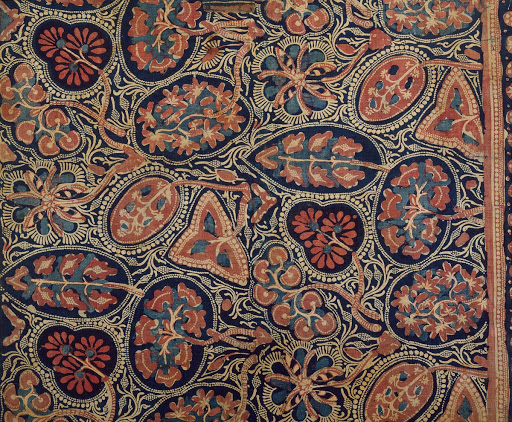The story of textiles in India is one of the oldest in the world. The earliest surviving Indian cotton threads date to around 4000 BC and dyed fabrics from the region are documented as far back as 2500 BC. India’s textiles were so central to its identity abroad that in ancient Greece and Babylon the very name ‘India’ was shorthand for ‘cotton’. India’s textiles are embedded in every aspect of its identity. Courtly splendour was proclaimed by magnificent fabrics and religious worship still finds expression through cloth. Global trade systems were formed on the export of Indian fabrics, and the hand-making of cloth continues to shape India today.

Nature and Making
India’s rich natural resources for making and decorating textiles are unrivalled. The varied geographical regions and climates provide a huge range of plant fibres and natural dyes for the cultivators, weavers, dyers, printers and embroiderers of the subcontinent. Over centuries, most regions developed specialities based on local resources: the golden silks of Assam, the fine cottons of Bengal, the red dyes of south-east India. Textile makers use an astonishing range of skills to process raw materials and produce regionally distinctive dyes, weaves, prints and embroideries.

Raw
Cotton and silk are the raw materials most associated with Indian textiles. India supplied cotton cloth to the world for centuries. The country also produced an astonishing variety of hand-made fabrics for domestic use until industrialisation changed how cottons were made and sold. India’s wild and semi-domesticated silks (quite distinct from that of cultivated mulberry silkworms) continue to provide a huge range of yarn and fabric for local use. Other animal fibres used to make textiles include sheep’s wool and yak- and goat-hair. Finished textiles are also often decorated with natural products – insect wings, mica and cowrie shells.

Woven winds
The ancient Romans called India’s finest cottons ‘woven winds’ because of their airy lightness. The country’s cotton fabrics range from the sheerest muslin to robust pieces for everyday use, though fine cottons in particular were much sought after and are a key element of India’s supremacy in textiles.

Credits:
The Victoria and Albert Museum is the world’s leading museum of art and design, housing a permanent collection of over 2.3 million objects that span over 5,000 years of human creativity.
